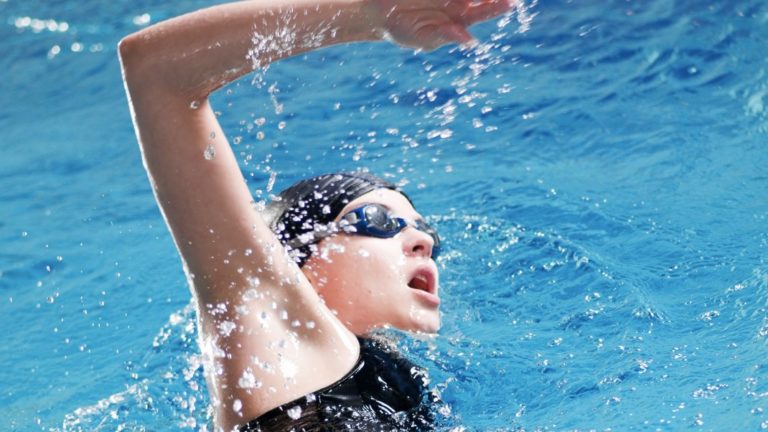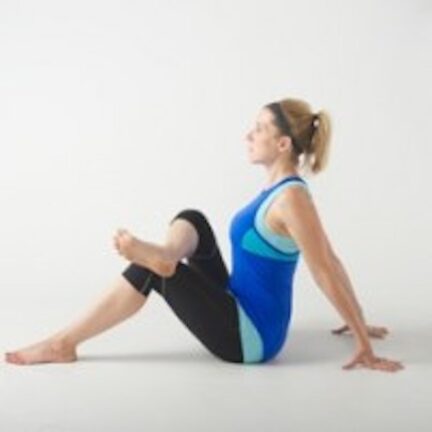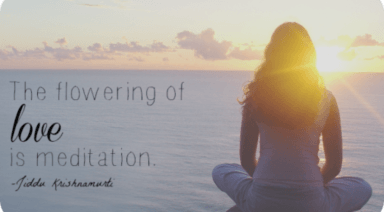4 Tips for Turning Swimming into a Moving Meditation

I used to dismiss swimming as boring. It lacked the rush of running on a frosty day or the adrenaline edge of cycling. But a foray into triathlon has forced me into the water and I realized that I had totally missed the point.
Swimming is not dull but is, in fact, the ultimate, stripped-down moving meditation. The inability to see almost anything except the line at the bottom of the pool, and hear nothing but the rush of water, creates an insulating, cocooning effect.
It’s a kind of enforced underwater Pratyahara or “sense withdrawal”—the fifth element of yoga as described by the sage Patañjali in his Yoga Sutras. Shutting out external stimuli, such as the glare of the swimming pool lights or drone of pop music, lets the mind settle.
This is not a sitting stock still and cross-legged meditation, but a moving meditation. It’s a little like the Zen walking version but with more flow. This sensation of flow comes from both the literal fluidity of the water and from the natural gliding action of swimming.
Watch an elite swimmer as she slides with grace: cutting and drawing back, reaching, extending. Every stroke and tilt is designed to be aerodynamic and dolphin-like, but the result is something very yogic. There is no jolting or jarring but a steady, smooth rhythm.
Granted, the pros always make it look effortless, but anyone can transform their swimming into a moving meditation if it doesn’t already feel like one.
Here are a few suggestions:
- Slow it Down
For a more yogic approach to swimming it is necessary to slow down. Ignore the clock on the wall. Take guidance from the “Total Immersion” school of swimming whose founder, Terry Laughlin, asks his students to take “yoga breaths” between laps and rotate their bodies to be both streamlined and unhurried. By doing this, the stressful urge to gulp air is removed. Arms don’t flail but extend and pull back in slow motion. The result is surprisingly relaxing as there is ample time to breathe.
- Find a Comfortable Breathing Rhythm
If you are new to freestyle, take time to learn the breathing technique. A good coach will teach you how to breathe comfortably within a few weeks. Once the mechanics of breathing are there, you can become more mindful. Alternatively, substitute a different stroke that doesn’t require synchronizing breathing with head tilting and arm coordination. Breast stroke is a good option.
- Exhale Through the Nose
Whether you’re swimming freestyle or breast stroke, release the exhale as a slow trickle through the nose. This will not only slow the whole breathing process down, but it will also create a pleasing trail of bubbles which you can observe in the next stage. If this is not possible, purse your lips and softly blow the air out to narrow the flow of air.
- Latch Onto One Element
Once you have found a happy swimming rhythm, or an inkling of flow, begin to latch onto the following visual or auditory elements of your swim:
- The sound the trail of bubbles make as they escape from your nose. - The rolling sensation of the body as it tilts from side to side. - The shape of the arm as it lifts out of the water. - The "hole" the fingertips make as they dip into the water. - The paddle-like action of the feet. Just like any meditation, there is no right or wrong. Resist the urge to criticize your breathing technique or stroke action. Practice observing in a detached manner by either sticking with one element or moving through the body from the fingertip dip to the paddle feet.
10 Fun Facts About Breathing & the Respiratory System

Our ability to breathe is fascinating, as it’s one of the only systems in our body that can be controlled both voluntarily, through the central nervous system, and more often involuntarily, through the autonomic nervous system. This overlap between the two systems is the reason why focused, intentional breathing methods through yoga and meditation are able to affect other involuntary muscles like the heart.
Our breath is what gives us life and without it, the human body cannot exist. But is it possible to better your life by paying more attention to how you breathe?
While breathing is so commonplace to our existence, proper breathing techniques and awareness of breath can have dramatic implications on our health. Having knowledge of specific breathing techniques can lower stress, help you sleep, help your mind function more acutely, and even curb food cravings.
When we breathe, the average adult draws in about 13 pints of air into the lungs every minute. From the lungs, that oxygen is then transferred from the air sacs in our lungs throughout the body via red blood cells to the blood vessels that distribute it to nearly every system. Meanwhile, waste gases, like CO2, are exchanged and filtered out.
For the average person with good lung health, the amount of oxygen in the blood, or the arterial blood gas (ABG) oxygen level, should be somewhere between 95-100 percent oxygen.
















